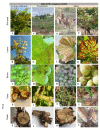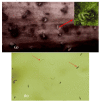Fungal Grapevine Trunk Diseases in Romanian Vineyards in the Context of the International Situation
- PMID: 36145437
- PMCID: PMC9503734
- DOI: 10.3390/pathogens11091006
Fungal Grapevine Trunk Diseases in Romanian Vineyards in the Context of the International Situation
Abstract
Vitis vinifera, known as the common grape vine, represents one of the most important fruit crops in the world. Romania is a wine-producing country with a rich and long tradition in viticulture. In the last decade, increasing reports of damage caused by grapevine trunk diseases (GTDs) have raised concerns in all wine producing countries. Up to now, no study was performed regarding the GTDs situation in Romania, an important grapevine grower in Europe. In this study, we aim, after a comprehensive presentation of the fungal GTDs worldwide, to review the scientific information related to these diseases in Romania in order to open a national platform in an international framework. In order to achieve this, we consulted over 500 references from different scientific databases and cited 309 of them. Our review concludes that, in Romania, there is little amount of available literature on this matter. Three out of six fungal GTDs are reported and well documented in all of the Romanian viticultural zones (except for viticultural zone 4). These are Eutypa dieback, Phomopsis dieback, and Esca disease. Of the fungal pathogens considered responsible Eutypa lata, Phomopsis viticola and Stereum hirsutum are the most studied and well documented in Romania. Management measures are quite limited, and they mostly include preventive measures to stop the GTDs spread and the removal of affected grapevines.
Keywords: GTD management; Romanian vineyards; fungal pathogens; grapevine trunk diseases (GTDs).
Conflict of interest statement
The authors declare no conflict of interest. The funders had no role in the design of the study; in the collection, analyses, or interpretation of data; in the writing of the manuscript; or in the decision to publish the results.
Figures








Similar articles
-
A Systematic Survey on Prevalence of Grapevine Trunk Disease Pathogens in Oregon Vineyards.Plant Dis. 2023 May;107(5):1355-1364. doi: 10.1094/PDIS-05-22-1220-RE. Epub 2023 May 17. Plant Dis. 2023. PMID: 36089679
-
Microbial Biological Control of Fungi Associated with Grapevine Trunk Diseases: A Review of Strain Diversity, Modes of Action, and Advantages and Limits of Current Strategies.J Fungi (Basel). 2023 May 31;9(6):638. doi: 10.3390/jof9060638. J Fungi (Basel). 2023. PMID: 37367574 Free PMC article. Review.
-
Phytotoxic Metabolites Produced by Fungi Involved in Grapevine Trunk Diseases: Progress, Challenges, and Opportunities.Plants (Basel). 2022 Dec 5;11(23):3382. doi: 10.3390/plants11233382. Plants (Basel). 2022. PMID: 36501420 Free PMC article. Review.
-
The Compositional Turnover of Grapevine-Associated Plant Pathogenic Fungal Communities Is Greater Among Intraindividual Microhabitats and Terroirs than Among Healthy and Esca-Diseased Plants.Phytopathology. 2022 May;112(5):1029-1035. doi: 10.1094/PHYTO-05-21-0190-R. Epub 2022 Apr 2. Phytopathology. 2022. PMID: 34752137
-
Diversity Profiling of Grapevine Microbial Endosphere and Antagonistic Potential of Endophytic Pseudomonas Against Grapevine Trunk Diseases.Front Microbiol. 2020 Mar 26;11:477. doi: 10.3389/fmicb.2020.00477. eCollection 2020. Front Microbiol. 2020. PMID: 32273871 Free PMC article.
Cited by
-
Molecular identification and antimicrobial potential of endophytic fungi against some grapevine pathogens.PLoS One. 2024 Oct 24;19(10):e0309041. doi: 10.1371/journal.pone.0309041. eCollection 2024. PLoS One. 2024. PMID: 39446969 Free PMC article.
-
In Vitro Evaluation of Some Endophytic Bacillus to Potentially Inhibit Grape and Grapevine Fungal Pathogens.Plants (Basel). 2023 Jul 5;12(13):2553. doi: 10.3390/plants12132553. Plants (Basel). 2023. PMID: 37447114 Free PMC article.
-
Discovery of Novel Phenolic Compounds from Eutypa lata Through OSMAC Approach: Structural Elucidation and Antibiotic Potential.Int J Mol Sci. 2025 Jun 16;26(12):5774. doi: 10.3390/ijms26125774. Int J Mol Sci. 2025. PMID: 40565239 Free PMC article.
-
Xylem Sap Mycobiota in Grapevine Naturally Infected with Xylella fastidiosa: A Case Study: Interaction of Xylella fastidiosa with Sclerotinia sclerotiorum.Plants (Basel). 2025 Jun 27;14(13):1976. doi: 10.3390/plants14131976. Plants (Basel). 2025. PMID: 40647985 Free PMC article.
-
Editorial: Fungal pathogens causing the grapevine trunk diseases- biology and identification.Front Fungal Biol. 2023 Apr 12;4:1186166. doi: 10.3389/ffunb.2023.1186166. eCollection 2023. Front Fungal Biol. 2023. PMID: 37746124 Free PMC article. No abstract available.
References
-
- Kottek M., Grieser J., Beck C., Rudolf B., Rubel F. World Map of the Köppen-Geiger Climate Classification Updated. Meteorol. Z. 2006;15:259–263. doi: 10.1127/0941-2948/2006/0130. - DOI
-
- Irimia L.M., Patriche C.V., Roșca B. Climate Change Impact on Climate Suitability for Wine Production in Romania. Theor. Appl. Climatol. 2018;133:1–14. doi: 10.1007/s00704-017-2156-z. - DOI
-
- Chiurciu I.-A., Zaharia I., Soare E. Production of Wine Grapes and Cultural Traditions Related to Vine in Romania. Sci. Pap. Ser. Manag. Econ. Eng. Agric. Rural Dev. 2020;20:133–143.
-
- ANF-Autoritatea Naționlă Fitosanitară (Romanian national phytosanitary authority) Ghid Pentru Recunoașterea Și Combaterea Bolilor Și Dăunătorilor La Vița de Vie [Guide to Recognizing and Fighting Diseases and Pests of Grapevine RO] Autoritatea Naţională Fitosanitară; Voluntari, Romania: 2016.
Publication types
LinkOut - more resources
Full Text Sources

